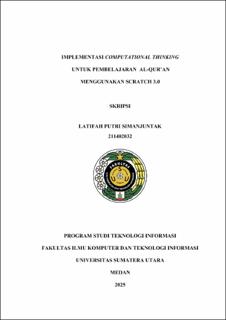| dc.description.abstract | This study was conducted to implement the Computational thinking approach in Qur’an
learning through an educational game developed using Scratch 3.0. The main problems
faced by elementary school students in memorizing the Qur’an (muroja’ah) are low
motivation, difficulty in remembering the sequence of verses, and less engaging
memorization methods. Therefore, this game was designed with four interactive menus:
Ayo Menghafal (Let’s Memorize), Susun Ayat (Arrange the Verses), Tebak Ayat (Guess
the Verse), and At-Takwir Bercerita (The Story of At-Takwir), focusing on Surah At
Takwir. The game was developed using the Game Development Life Cycle (GDLC)
methodology and applies the four components of Computational thinking:
Decomposition, abstraction, pattern recognition, and algorithm design. The
gamification of Qur’an learning proved effective in improving students’ learning
outcomes. This is evidenced by the increase in the average score of the Arrange the
Verses menu from 65.19 to 90, and the Guess the Verse menu from 61.48 to 86.67. In
addition, students’ responses to the learning game were also highly positive, both in
terms of design, ease of use, and benefits for Qur’an learning. A total of 84.26% of
respondents stated that the colors and visuals in the game were attractive, 91.67%
reported they did not feel confused when navigating the game menus, and 94.44% felt
more motivated to study the Qur’an after playing the game.In conclusion, the use of a
Computational thinking-based game has proven effective in creating a more engaging
learning atmosphere, enhancing understanding, and encouraging active participation
among elementary school students in Qur’an learning.
Keywords: Gamification, Computational thinking, Scratch 3.0, Qur’an memorization
(muroja’ah), Game Development Life Cycle (GDLC), interactive learning, Surah At
Takwir. | en_US |


